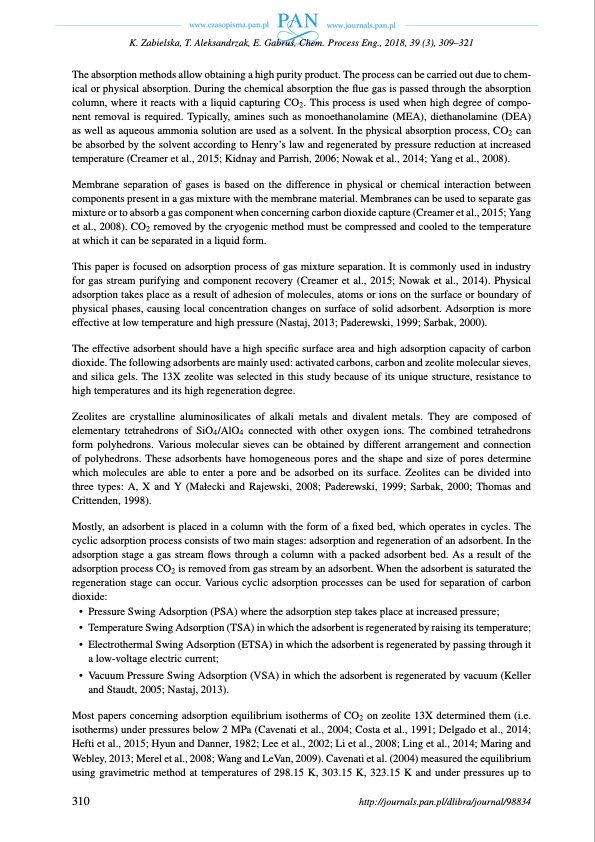
PDF Publication Title:
Text from PDF Page: 002
K. Zabielska, T. Aleksandrzak, E. Gabrus ́, Chem. Process Eng., 2018, 39 (3), 309–321 The absorption methods allow obtaining a high purity product. The process can be carried out due to chem- ical or physical absorption. During the chemical absorption the flue gas is passed through the absorption column, where it reacts with a liquid capturing CO2. This process is used when high degree of compo- nent removal is required. Typically, amines such as monoethanolamine (MEA), diethanolamine (DEA) as well as aqueous ammonia solution are used as a solvent. In the physical absorption process, CO2 can be absorbed by the solvent according to Henry’s law and regenerated by pressure reduction at increased temperature (Creamer et al., 2015; Kidnay and Parrish, 2006; Nowak et al., 2014; Yang et al., 2008). Membrane separation of gases is based on the difference in physical or chemical interaction between components present in a gas mixture with the membrane material. Membranes can be used to separate gas mixture or to absorb a gas component when concerning carbon dioxide capture (Creamer et al., 2015; Yang et al., 2008). CO2 removed by the cryogenic method must be compressed and cooled to the temperature at which it can be separated in a liquid form. This paper is focused on adsorption process of gas mixture separation. It is commonly used in industry for gas stream purifying and component recovery (Creamer et al., 2015; Nowak et al., 2014). Physical adsorption takes place as a result of adhesion of molecules, atoms or ions on the surface or boundary of physical phases, causing local concentration changes on surface of solid adsorbent. Adsorption is more effective at low temperature and high pressure (Nastaj, 2013; Paderewski, 1999; Sarbak, 2000). The effective adsorbent should have a high specific surface area and high adsorption capacity of carbon dioxide. The following adsorbents are mainly used: activated carbons, carbon and zeolite molecular sieves, and silica gels. The 13X zeolite was selected in this study because of its unique structure, resistance to high temperatures and its high regeneration degree. Zeolites are crystalline aluminosilicates of alkali metals and divalent metals. They are composed of elementary tetrahedrons of SiO4/AlO4 connected with other oxygen ions. The combined tetrahedrons form polyhedrons. Various molecular sieves can be obtained by different arrangement and connection of polyhedrons. These adsorbents have homogeneous pores and the shape and size of pores determine which molecules are able to enter a pore and be adsorbed on its surface. Zeolites can be divided into three types: A, X and Y (Małecki and Rajewski, 2008; Paderewski, 1999; Sarbak, 2000; Thomas and Crittenden, 1998). Mostly, an adsorbent is placed in a column with the form of a fixed bed, which operates in cycles. The cyclic adsorption process consists of two main stages: adsorption and regeneration of an adsorbent. In the adsorption stage a gas stream flows through a column with a packed adsorbent bed. As a result of the adsorption process CO2 is removed from gas stream by an adsorbent. When the adsorbent is saturated the regeneration stage can occur. Various cyclic adsorption processes can be used for separation of carbon dioxide: • Pressure Swing Adsorption (PSA) where the adsorption step takes place at increased pressure; • TemperatureSwingAdsorption(TSA)inwhichtheadsorbentisregeneratedbyraisingitstemperature; • Electrothermal Swing Adsorption (ETSA) in which the adsorbent is regenerated by passing through it a low-voltage electric current; • Vacuum Pressure Swing Adsorption (VSA) in which the adsorbent is regenerated by vacuum (Keller and Staudt, 2005; Nastaj, 2013). Most papers concerning adsorption equilibrium isotherms of CO2 on zeolite 13X determined them (i.e. isotherms) under pressures below 2 MPa (Cavenati et al., 2004; Costa et al., 1991; Delgado et al., 2014; Hefti et al., 2015; Hyun and Danner, 1982; Lee et al., 2002; Li et al., 2008; Ling et al., 2014; Maring and Webley, 2013; Merel et al., 2008; Wang and LeVan, 2009). Cavenati et al. (2004) measured the equilibrium using gravimetric method at temperatures of 298.15 K, 303.15 K, 323.15 K and under pressures up to 310 http://journals.pan.pl/dlibra/journal/98834PDF Image | ADSORPTION EQUILIBRIUM OF CARBON DIOXIDE ON ZEOLITE

PDF Search Title:
ADSORPTION EQUILIBRIUM OF CARBON DIOXIDE ON ZEOLITEOriginal File Name Searched:
Adsorption_equilibrium_of_carbon_di.pdfDIY PDF Search: Google It | Yahoo | Bing
CO2 Organic Rankine Cycle Experimenter Platform The supercritical CO2 phase change system is both a heat pump and organic rankine cycle which can be used for those purposes and as a supercritical extractor for advanced subcritical and supercritical extraction technology. Uses include producing nanoparticles, precious metal CO2 extraction, lithium battery recycling, and other applications... More Info
Heat Pumps CO2 ORC Heat Pump System Platform More Info
| CONTACT TEL: 608-238-6001 Email: greg@infinityturbine.com | RSS | AMP |